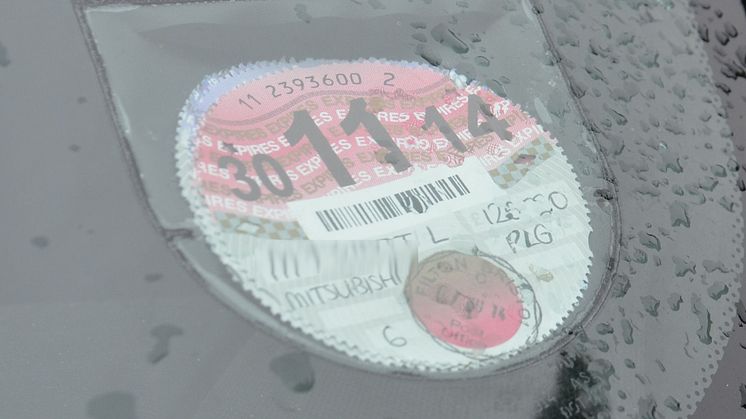
Press release -
DVLA annual accounts show a £93m loss in revenue following the abolition of the paper tax disc
Revenue from vehicle excise duty has fallen by £93m in the year following the abolition of the paper tax disc, the Driver and Vehicle Licensing Agency’s newly published annual report and accounts show*.
The DVLA’s accounts show revenue from vehicle tax fell from £6.023bn at the end of March 2015 to £5.930bn a year later.
The RAC, which was fearful that the impact of the scrapping of the tax disc would lead to a loss in revenue due to increased evasion, is now concerned the loss has proved to be even greater than the Government’s own estimate of £80m over the course of 2015.
A year ago the Department for Transport conducted a roadside survey which projected that about 1.5% of all vehicles on the road were unlicensed – the equivalent of about 560,000 vehicles – a rate of 1.4% unlicensed vehicles, compared with 0.6% in 2013 – or the equivalent of 210,000 vehicles.
As a result the Department's statisticians estimated a loss to the exchequer of around £80 million. In Great Britain specifically they estimated annual losses would rise from £35m in June 2013 to £78m in June 2015.
While the RAC understands there may be other factors affecting the DVLA’s revenue loss such as greater numbers of ‘cheaper to tax’ low carbon emission vehicles being taxed, it is concerned the figure may continue to rise in the coming years as a result of increased evasion.
In order to understand the true extent of the evasion problem, the RAC believes another roadside survey of unlicensed vehicles should be carried out this summer – a year earlier than it would normally be undertaken – so the Government can get an up-to-date assessment of the evasion situation.
RAC spokesman Simon Williams said: “It is worrying that the reduction in revenue from vehicle tax has exceeded the Government’s own estimate. Some may argue that a £93m loss is only £13m higher than expected, this represents an increase of £58 million on the corresponding period before the tax disc was abandoned and far exceeds the £10 million savings arising from no longer issuing tax discs. This loss is a significant sum and one that merits further investigation.
“While there are several factors which may have adversely contributed to a reduction in revenue including unfamiliarity with the new system and greater numbers of ‘cheaper to tax’ low carbon emission vehicles being taxed, we need to fully understand how great a part evasion plays. We therefore urge the Department for Transport to carry out another roadside survey of unlicensed vehicles this year to fully assess the untaxed vehicle situation. If this were to find that the number of untaxed vehicles is still at the same rate as when the last survey was conducted or, worse still, has increased, then action needs to be taken urgently to counter this.”
In September 2014 the RAC estimated the Treasury could lose up to £132m** on top of the £35m the DVLA said was lost from evasion the year before, making for a total loss of £167m. This was based on vehicle tax evasion following a similar path to the number of uninsured drivers of which there are believed to be around one million illegally using Britain’s roads.
“Now that paper tax discs have disappeared from the windscreen of vehicles, payment is logged within the DVLA database and the country’s network of automatic number plate recognition cameras are relied upon to catch motorists who avoid paying – deliberately or not, together with a debt collection agency which is used to chase non-payers.
“As these same cameras are also used to catch uninsured drivers, of which there are estimated to be over a million, we felt it was reasonable to model the number of car tax evaders on this figure which showed us that lost revenue from evaders could increase dramatically.
“It would be extremely worrying if we were to find that car tax evasion has increased from the 560,000 figure estimated in June 2015. We just hope that this doesn’t prove to be the tip of the iceberg and that the figure does not keep on rising, especially as the DVLA had predicted the new system would lead to savings of £10m.”
Topics
Categories
Notes to Editors
About the RAC
With more than eight million members, the RAC is one of the UK's most progressive motoring organisations, providing services for both private and business motorists. Whether it's roadside assistance, insurance, buying a used car, vehicle inspections and checks, legal services or up-to-the-minute traffic and travel information – the RAC offers a solution for all motoring needs. The RAC is committed to making motoring easier, safer, more affordable and more enjoyable for drivers and road users.
The RAC is the motorist’s champion and campaigns to support the interests of its members and UK motorists at a national level, including advancing levels of road safety, supporting the needs of young drivers and voicing concerns about the increasing cost of motoring. The RAC’s annual Report on Motoring – first published in 1989 – provides a clear insight into the concerns and issues facing today’s motorists.
For the very latest news on UK fuel prices, check RAC Fuel Watch or follow #racfuelwatch on Twitter. This is a comprehensive guide to the latest UK unleaded petrol and diesel prices – both at the wholesale level and at the pump. RAC Fuel Watch analyses how prices changed through the previous month and compares the most recent prices with those from three, six and 12 months before.
Key facts:
- RAC patrols fix four out of five vehicles at the roadside and on average within 30 minutes
- RAC vans carry more than 500 parts and tools to get members’ vehicles going again
- 92% of members would recommend RAC Rescue to their friends and family


